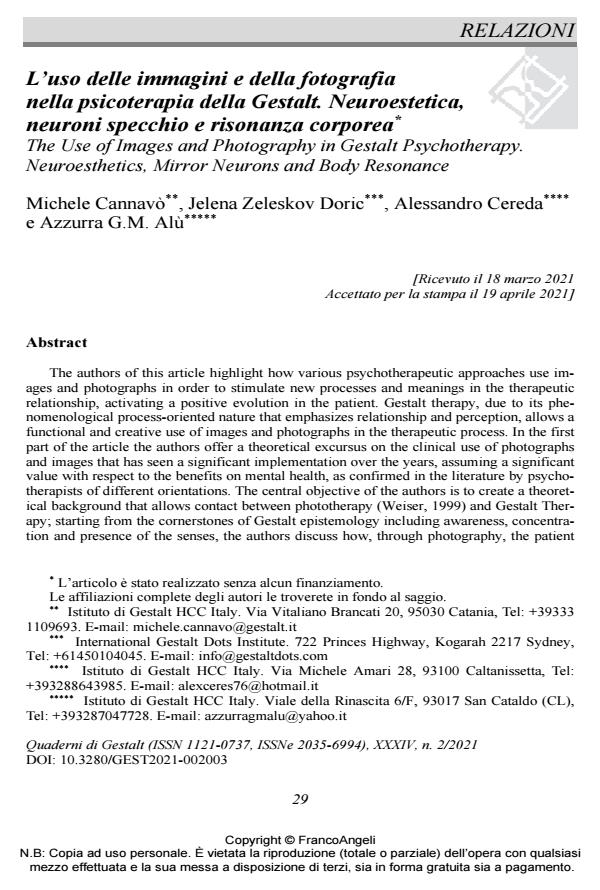The Use of Images and Photography in Gestalt Psychotherapy. Neuroesthetics, Mirror Neurons and Body Resonance
Journal title QUADERNI DI GESTALT
Author/s Michele Cannavò, Jelena Zeleskov Doric, Alessandro Cereda, Azzurra G.M. Alù
Publishing Year 2021 Issue 2021/2
Language Italian Pages 15 P. 29-43 File size 197 KB
DOI 10.3280/GEST2021-002003
DOI is like a bar code for intellectual property: to have more infomation
click here
Below, you can see the article first page
If you want to buy this article in PDF format, you can do it, following the instructions to buy download credits

FrancoAngeli is member of Publishers International Linking Association, Inc (PILA), a not-for-profit association which run the CrossRef service enabling links to and from online scholarly content.
The authors of this article highlight how various psychotherapeutic approaches use images and photographs in order to stimulate new processes and meanings in the therapeutic relation-ship, activating a positive evolution in the patient. Gestalt therapy, due to its phenomenological process-oriented nature that emphasizes relationship and perception, allows a functional and creative use of images and photographs in the therapeutic process. In the first part of the article the authors offer a theoretical excursus on the clinical use of photographs and images that has seen a significant implementation over the years, assuming a significant value with respect to the benefits on mental health, as confirmed in the literature by psychotherapists of different orientations. The central objective of the authors is to create a theoretical background that al-lows contact between phototherapy (Weiser, 1999) and Gestalt Therapy; starting from the cor-nerstones of Gestalt epistemology including awareness, concentration and presence of the senses, the authors discuss how, through photography, the patient can rediscover a different and creative mode of contact, capable of opening a new proprioceptive narrative path. Another objective of the authors is to highlight the correlation between recent neuroscientific research on mirror neurons, the field of investigation of neuroaesthetics, the concept of "Aesthetic Rela-tional Knowledge" (Spagnuolo Lobb, 2013) and that of body resonance, offering a scientific framework that reinforces the validity of the use of photography in the transformative thera-peutic processes in the Gestalt field. The authors show how the connection between images and body resonance described by Freedberg (2009) can be superimposed on the clinical work carried out with the use of images in a therapeutic setting using photos chosen by the patient and shared with the therapist. Senses, perception, body, subjectivity, art and embodied emo-tions, central themes of neuroaesthetics, are also fundamental in the epistemology of Gestalt therapy, where on the clinical level, in the here and now of the relationship, the individual rec-ognises himself and moves energy and intentionality towards the other. In the second part of the article, the authors offer an example of clinical application in a Gestalt psychotherapeutic setting of the images and principles of phototherapy.
Keywords: Gestalt psychotherapy, phototherapy, Aesthetic Relational Knowledge, neuroscience, body resonance.
Michele Cannavò, Jelena Zeleskov Doric, Alessandro Cereda, Azzurra G.M. Alù, L’uso delle immagini e della fotografia nella psicoterapia della Gestalt. Neuroestetica, neuroni specchio e risonanza corporea in "QUADERNI DI GESTALT" 2/2021, pp 29-43, DOI: 10.3280/GEST2021-002003